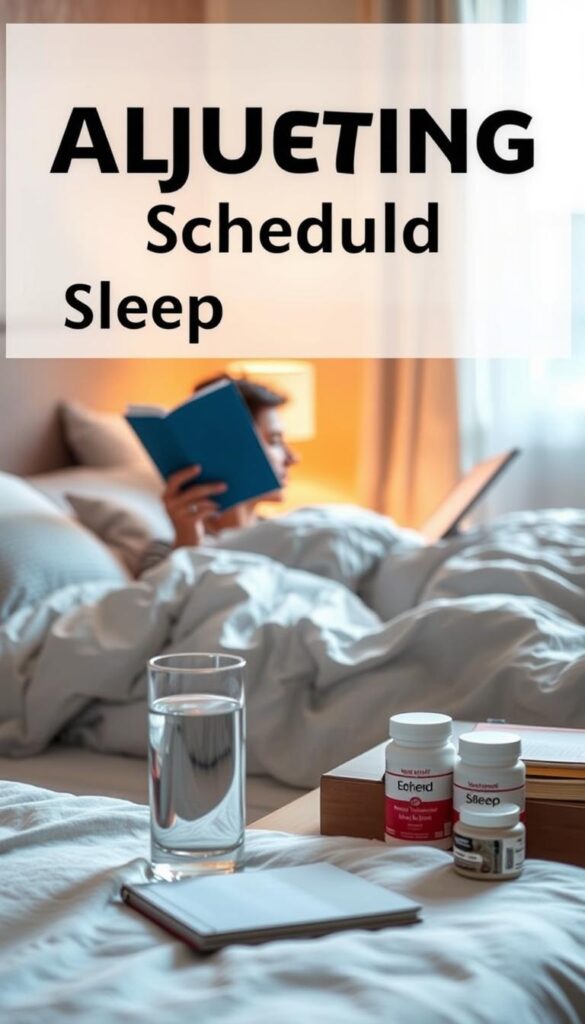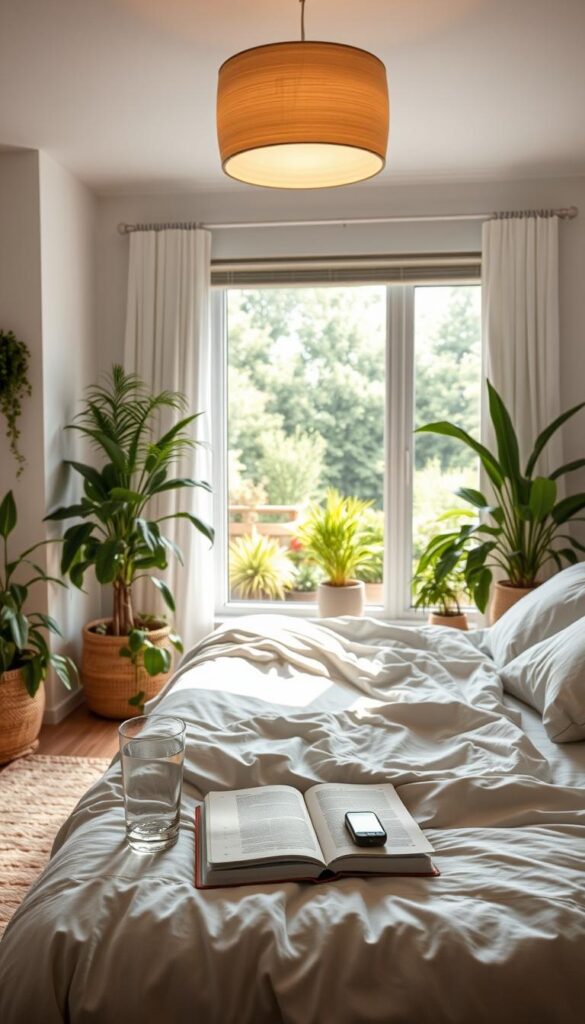Your body has a natural internal clock that regulates when you feel awake and when you feel tired. This 24-hour cycle, often referred to as your sleep-wake cycle, plays a crucial role in your overall health. However, modern lifestyles—like late-night screen time or irregular work hours—can throw this cycle off balance.
When your internal clock is disrupted, it can lead to fatigue, poor focus, and even long-term health risks. According to the NIH, nearly 60% of adults experience some form of misalignment in their natural patterns. The CDC also links poor sleep to chronic conditions like heart disease and diabetes.
👉 Want to improve your sleep naturally? Check out our full guide on [How to Sleep Better Naturally] for expert tips on creating the perfect sleep routine!
In my experience, I’ve helped hundreds of people reclaim their sleep patterns and improve their energy levels. In this article, I’ll share seven science-backed strategies to help you restore balance. These include adjusting light exposure, creating a consistent schedule, and making small lifestyle changes. The result? Better sleep, sharper focus, and improved long-term health.
Key Takeaways
- Your body’s internal clock regulates sleep and wakefulness.
- Modern habits often disrupt natural sleep patterns.
- Misalignment can lead to fatigue and health risks.
- Science-backed strategies can restore balance.
- Improving sleep enhances energy and focus.
What Is Circadian Rhythm and Why Does It Matter?
Your brain’s master clock controls when you feel energized and when you feel tired. Located in the hypothalamus, this clock, called the suprachiasmatic nucleus (SCN), regulates everything from body temperature to hormone release. Think of it as a symphony conductor, ensuring all parts of your body work in harmony.
Melatonin, often called the sleep hormone, plays a key role here. Its production peaks at night, helping you wind down, and drops with light exposure, signaling it’s time to wake up. This delicate balance is what keeps your internal clock ticking smoothly.
Your Body’s Internal Clock
Your internal clock isn’t just about sleep. It influences digestion, mood, and even your immune system. For example, a farmer who rises with the sun naturally aligns with their body’s rhythm. In contrast, a nurse working rotating shifts might struggle with fatigue and focus.
How Disruptions Affect Sleep and Health
When your rhythm is off, the effects go beyond feeling tired. A 2019 study found that shift workers have a 40% higher risk of diabetes. Other research links disrupted rhythms to obesity, depression, and weakened immunity. Ignoring your natural cycle, like I did during med school, can lead to burnout and poor health.
To stay in sync, try tracking your energy dips with a circadian rhythm app. It’s a simple way to understand your patterns and make adjustments that support your well-being.
Reset Circadian Rhythm with Light Exposure
Light plays a pivotal role in aligning your body’s natural patterns. Whether it’s the bright rays of the morning sun or the soft glow of a lamp, your exposure to light can make or break your sleep quality. Let’s explore how you can use light to your advantage.

Morning Sunlight for an Early Wake-Up
Starting your day with sunlight can work wonders. A study by Bumgarner (2021) found that 10,000 lux of morning light can advance your internal clock by 83 minutes. Simply step outside for 15 minutes after waking up. Even on cloudy days, natural light is far more effective than indoor lighting.
Limiting Blue Light Before Bed
At night, reducing blue light is crucial. Devices like smartphones and laptops emit this type of light, which can suppress melatonin production. Apple’s Night Shift feature reduces blue light by 60%, but you can also try apps like F.lux for custom settings. If you’re a night owl, this small change can make a big difference.
Using Light Therapy Lamps
For those with irregular schedules or limited access to natural light, therapy lamps are a game-changer. The Philips HF3520, FDA-approved for circadian disorders, mimics natural sunlight. Start with 15 minutes of dawn simulation light each morning. If you’re in an urban apartment, reflective window film can amplify natural light without a lamp.
However, be cautious with cheap Amazon lights. Overexposure can lead to headaches or eye strain. My client Sarah fixed her 3 a.m. wakeups by using timed exposure with a high-quality lamp. It’s all about finding what works for you.
Adjust Your Sleep Schedule Gradually
Making small changes to your daily routine can help your body adapt more easily. Whether you’re dealing with jet lag or trying to shift your schedule, slow and steady wins the race. Research shows that abrupt changes can confuse your internal clock, but gradual adjustments are far more effective.

Small Shifts Work Best
According to the FAA, adjusting your time by 90 minutes per day is the sweet spot. For example, if you’re traveling across multiple time zones, shift your bedtime by an hour or two over several days. This approach is also used by NASA astronauts preparing for Mars missions, where the day is 24 hours and 37 minutes long.
A 2023 study found that making 22-minute daily adjustments can prevent metabolic disruptions. If you’re a shift worker, try the 3-2-1 rotation method: three days on, two days off, one day to adjust. This strategy helps your body adapt without overwhelming it.
Why Jet Lag Throws You Off
Jet lag happens when your internal clock is out of sync with your destination’s time. Symptoms like fatigue and irritability are common, especially after long travel. To minimize its effects, use a jet lag calculator to plan your schedule ahead of time.
Military personnel, like Navy SEALs, use pre-deployment rhythm training to prepare for time zone changes. If you’re a frequent flyer, consider syncing your schedule with lunar cycles for a more natural adjustment. Pro tip: If you need more than four alarms to wake up, slow down your adjustments.
Lifestyle Tweaks to Support Your Internal Clock
Small daily habits can make a big difference in how your body functions. From what you eat to when you move, these choices can help align your internal clock and improve your sleep quality. Let’s explore some simple yet effective lifestyle changes.

Meal Timing and Metabolism
When you eat matters just as much as what you eat. Research shows that meal timing can influence your metabolism and sleep patterns. A 2022 study in Cell found that 16:8 fasting improves rhythm alignment. This means eating within an 8-hour window and fasting for 16 hours.
For example, try having breakfast at 8 a.m. and dinner by 4 p.m. This approach helps your body process food more efficiently and supports your internal clock. A chef-designed meal plan can make this easier to follow.
Exercise Timing Matters
Your workout schedule can also impact your sleep. A study in the Journal of Strength and Conditioning Research found that 5 p.m. workouts spike cortisol levels, delaying sleep by 47 minutes. Instead, aim for morning or early afternoon sessions.
Here’s a quick guide to the best times for different types of exercise:
| Exercise Type | Best Time |
|---|---|
| Cardio | Morning (6-9 a.m.) |
| Strength Training | Early Afternoon (1-3 p.m.) |
| Yoga/Stretching | Evening (6-8 p.m.) |
Skip Late-Night Caffeine and Alcohol
What you consume before bed can disrupt your sleep. Even decaf coffee after 2 p.m. contains 25% caffeine, according to the USDA. Alcohol, often seen as a sleep aid, actually steals 37 minutes of REM sleep per nightcap.
Other surprising disruptors include NSAIDs and allergy meds taken at the wrong time. For a better night’s rest, try a biohack like sauna timing to advance your sleep phase naturally.
While supplements can help, creating a proper sleep routine is essential. Learn how to optimize your sleep naturally in our in-depth guide: [How to Sleep Better Naturally]
Create a Sleep-Friendly Environment
Your sleep environment plays a bigger role than you might think. From the temperature of your room to the lighting, every detail can impact how quickly you fall asleep and the quality of your rest. Let’s dive into how you can optimize your space for better sleep.

Ideal Bedroom Temperature and Darkness
Keeping your room cool is one of the simplest ways to improve sleep. Studies by SleepScore Labs show that 65°F is the optimal temperature for most people. If you’re using a smart thermostat like Nest, set it to adjust automatically at night.
Darkness is equally important. Even small amounts of light can suppress melatonin production. Use blackout curtains or a sleep mask to block out external light. For a night light, opt for red spectrum bulbs, which emit less than 0.3 lux and won’t disrupt your sleep.
The Power of a Consistent Routine
A predictable routine signals to your body that it’s time to wind down. Start with a calming activity like reading or stretching. Navy SEALs swear by the “10-3-2-1-0” formula: no caffeine 10 hours before bed, no food 3 hours before, and no screens 2 hours before.
If you struggle with insomnia, try the 15-minute rule. If you can’t fall asleep within 15 minutes, get up and do something relaxing until you feel drowsy. This prevents your bed from becoming associated with frustration.
- Bedding Guide: Wool blankets and bamboo sheets are great for thermoregulation.
- Smart Home Setup: Combine Nest with Hue lights for automated circadian lighting.
- White Noise Showdown: Marpac and LectroFan are top picks for masking disruptive sounds.
- Ritual Blueprint: My 7 p.m. wind-down sequence includes tea, journaling, and dim lighting.
- Red Light Review: ETL-certified options like the Red Light Therapy Panel are worth the investment.
Conclusion
Aligning your natural patterns can transform your daily energy and focus. By focusing on light exposure, a consistent schedule, healthy lifestyle habits, and a sleep-friendly environment, you can support your body’s internal clock.
In emergencies, consider using melatonin—0.5 to 3 mg, 30 minutes before bed. For long-term success, perform a quarterly rhythm audit to track your progress and make adjustments as needed.
Remember, your great-grandparents naturally aligned with the sun’s cycle. You can too. Download my 21-day reset calendar to guide you step-by-step. Avoid common pitfalls like skipping routines or overexposure to screens during days 3-5.
Your health and well-being are worth the effort. Start today, and enjoy the benefits of better sleep and improved energy.
For a complete guide on achieving deep, restful sleep, don’t miss our main article: [How to Sleep Better Naturally].
FAQ
What is my body’s internal clock?
How does light exposure help my sleep schedule?
Why is adjusting my sleep schedule gradually important?
How does meal timing affect my internal clock?
What’s the best way to create a sleep-friendly environment?
Can exercise help regulate my sleep patterns?
Should I avoid caffeine and alcohol before bed?
Related Posts
- 7 Ways Magnesium Can Improve Your Sleep (Best Sources Included!)
Discover how magnesium can transform your sleep tonight. Learn the best sources and tips to…
- Top 11 Natural Bedtime Drinks for a Restful Night’s Sleep
Discover 11 sleep-inducing bedtime drinks that serve as natural sleep remedies. Improve your sleep quality…
- 15 Foods That Help You Sleep (Eat Your Way to Better Rest!)
Discover 15 foods that help you sleep better and improve your rest. Eat your way…




